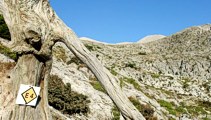And so, at 5.50 am, I set off on my last day of Part One of my Trans-Cretan Walk along the E4. The path up to the summit of Psiloritis is well-known and well-marked and does not need any further description from me. Fortunately for me, my pack was lighter by about 4 kg as I had handed over my camping equipment and extra food supplies to T who was going to catch the ferry back from Chania two days later and who could drop my gear at the flat en route.
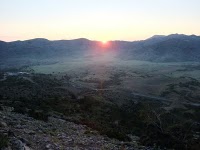
Nidha Plateau at sunrise
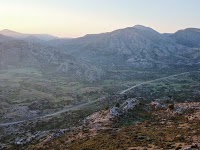
Looking southeast on the climb
up out of the Plateau

The Germans ahead of me on the E4 path
Also fortunate was the fact that two Germans, English language teachers with truly excellent English, were also making an early start for the summit (with day packs) so we paced each other along the path. They were walking faster than me but had to make regular stops to look at their map, while I had prior knowledge and could plod steadily on. There was still a lot of snow in the gullies – not surprising given the cold, wet Spring – and we had to cut steps across the snowdrift on the north eastern flank (unnecessarily as it turned out – the drift was only about ten meters high so we could have walked up and round it).
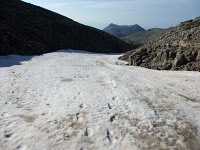
Long snow drift in the gully up
to the northern rim

The view south from the summit
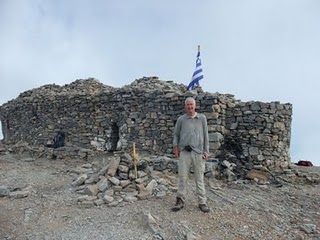
The author in front of
Timios Stavros
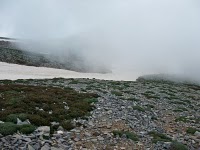
The cloud rolling in
We all three made it to the top by 0930 (in 3½ hours), just before the clouds rolled in from the north, so we missed the view of the north coast but had excellent views all round from east through south to the Amari valley below us to the west.
You would not want to make the descent in thick cloud as, initially, the path which leads down to the Toupotos Prinos hut is not that easy to find in poor visibility.
You walk back eastwards about 300 meters along the main path before there is a rash of red spots on your right (south side) marking the start of the path down to the hut. Even then, this path follows just below the ridge line for another 300 meters or so hardly losing any height before welcome E4 poles start to appear, guiding you southwards and downwards on a relatively gentle descent to Toupotos Prinos hut. I passed another two Germans coming up from the direction of the hut – making a total of 5 Germans and 2 French for the entire fortnight and no-one on the long-distance trail at all. As LW describes, the Toupotos Prinos hut has a welcome covered platform where you could shelter in bad weather (or good). It also has a cistern with water but this does not look as clean as it might be. I didn’t need to take on water here, but I think I would have put a tab in to be on the safe side.
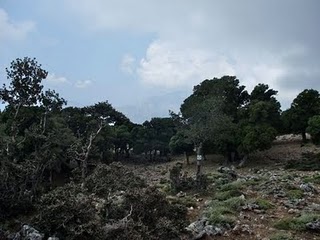
Finally an E4 sign
on the path down through
the woods towards Fourfouras
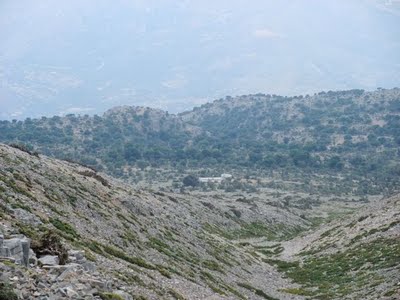
Looking down on the
Toumpotos Prinos hut on
the descent from Psiloritis
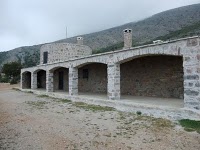
The covered platform
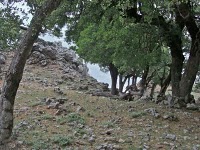
The start of
the steep descent
Finding the start of the E4 path from the hut was the usual nightmare. I blindly followed the GPS line through thick maquis and trees until E4 signs (nailed to trees) appeared again and from there on it was easy. Susa and I had explored this path a month earlier (when leaving supplies at Windy Place) and so I knew what to expect once the descent began. The path is very steep and (if there ever had been an engineered kalderimi in the past) broken - with dry, slippery oak leaves and acorns underfoot to add to the excitement. It is not a path to be rushed even if there is a bus to be caught at the bottom. However, it is quite passable and well shaded by the open oak forest with glimpses of the Amari Valley far below to tempt you on.
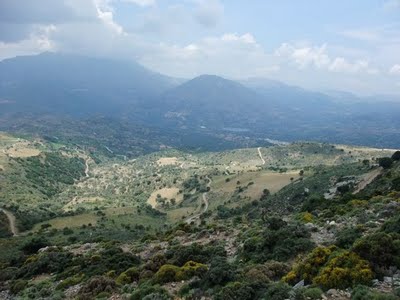
A welcome sight - the view northwest up the Amari valley
By and large, the path is well signed here. It brings you out at a trough and then, via a network of dirt roads, brings you down to the Aghios Georgios chapel just above the tarmac road into Fourfouras. Kostantina thought she would never see the last of me as I enjoyed yet another meal at Windy Place and waited for the bus. I needn’t have rushed – the bus was an hour late !
I needed a good long rest to get over the shin splint and the blisters before embarking on Part Two: Fourfouras to the west coast via the White Mountains.
